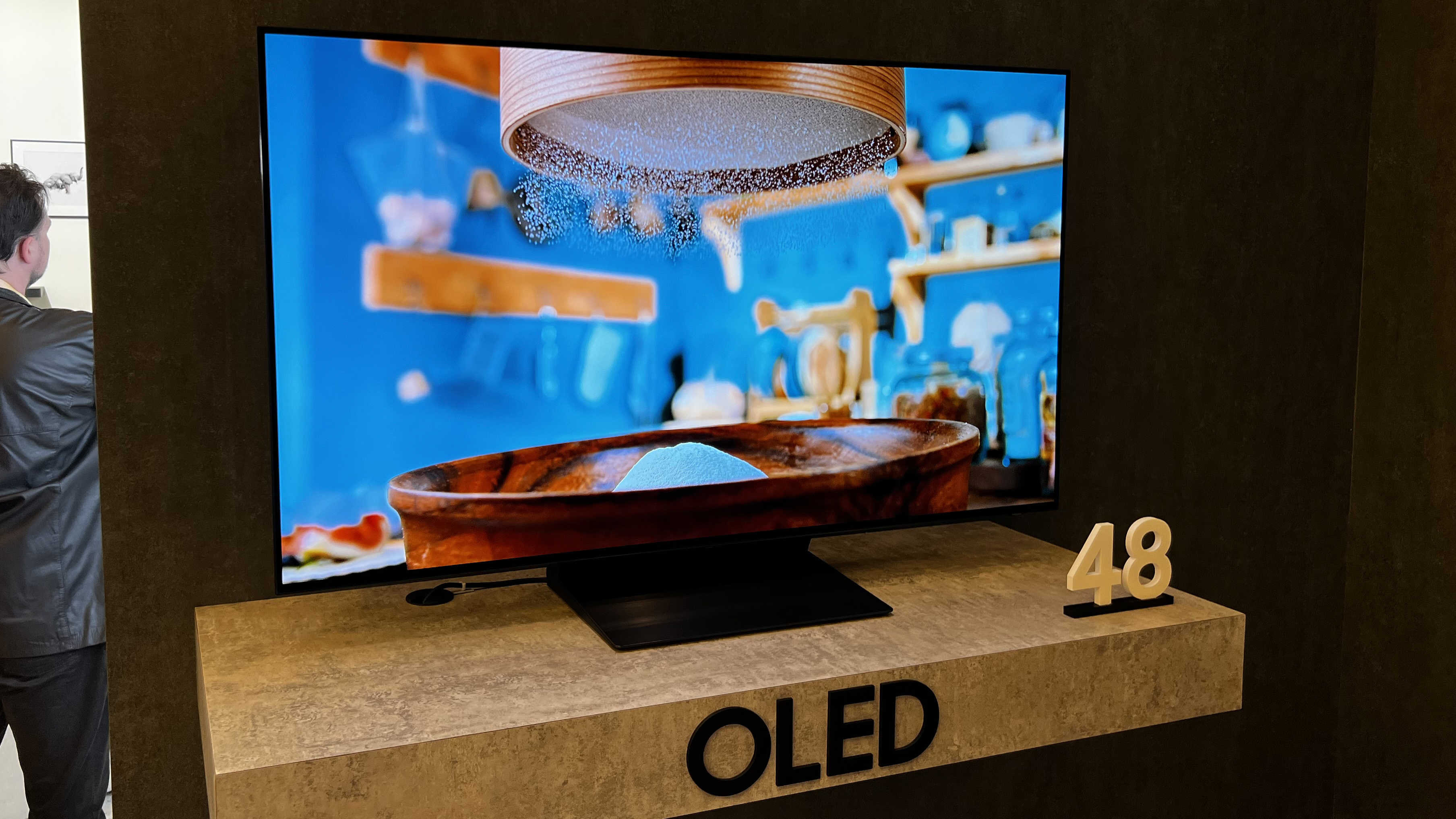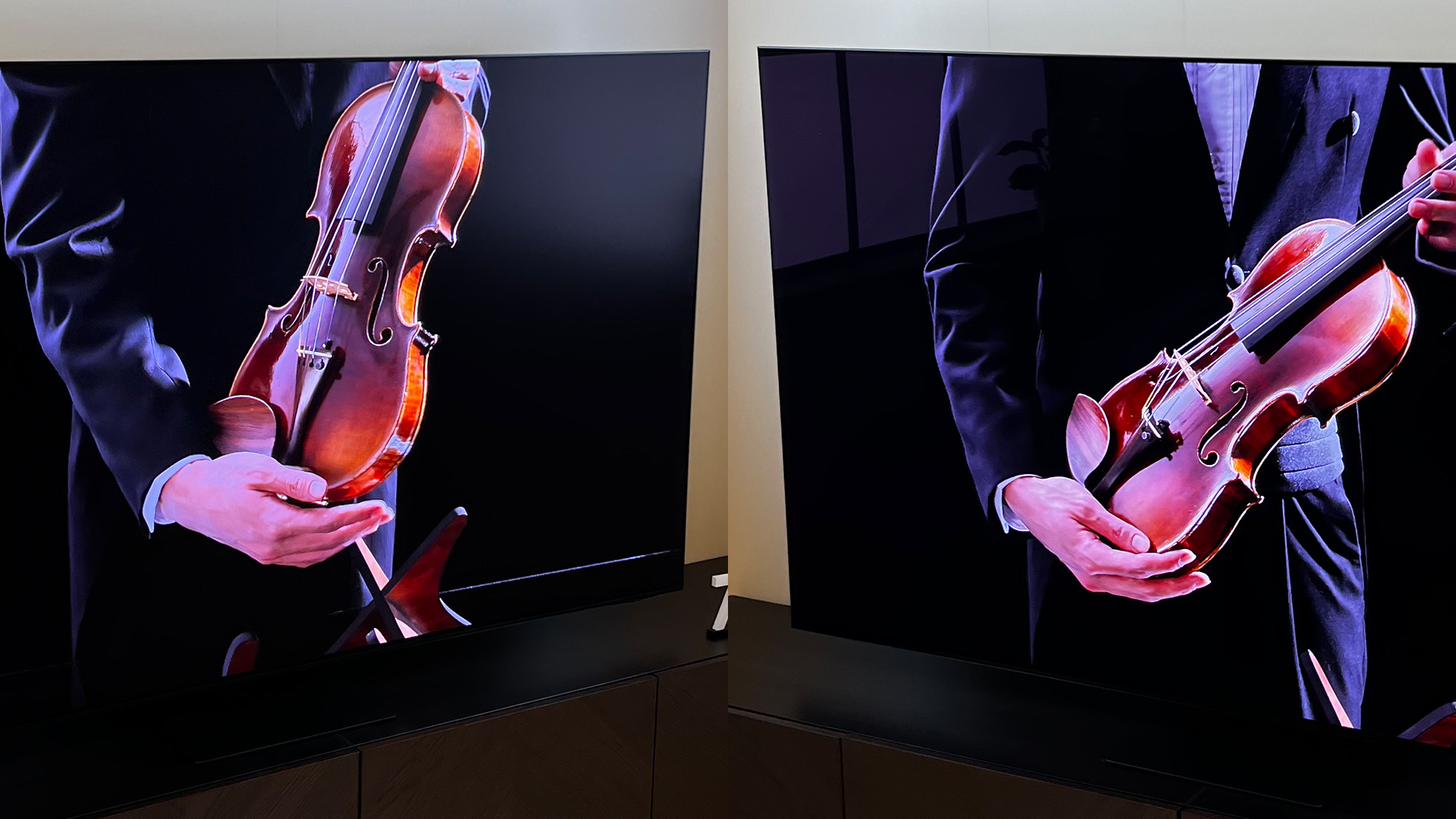Samsung S90D vs Samsung S95D: how does the mid-range QD-OLED compare to its flagship?
It's the battle of Samsung's two major 2024 QD-OLEDs

Samsung has unveiled its 2024 OLED TVs and as expected, we’re getting two new QD-OLED models: the mid-range Samsung S90D and flagship Samsung S95D. It also revealed the Samsung S85D, an entry-level OLED that will use regular W-OLED panels rather than the QD-OLED tech found in the S90D and S95D.
The Samsung S90D is the successor to the Samsung S90C, which is not only one of the best TVs from 2023, but was also our TV of the year at the TechRadar Choice Awards 2023. From what we’ve heard so far, it carries a lot of the same great features of its predecessor, but promises higher brightness (up to 20% higher than last year). The S90D also comes in two new sizes: a 42- and 48-inches. However, these two models will use W-OLED panels, not QD-OLED (more on that below).

The Samsung S95D, on the other hand, is the follow-up to the Samsung S95C, a TV that we named as one of the best OLED TVs from last year that offers the complete QD-OLED package, thanks to its stunning picture and full range of features. Again, the set carries across a lot of the same features as its predecessor.
The S95D’s most intriguing feature is its OLED Glare Free screen, an anti-reflection tech that Samsung says will limit reflections by up to 70% compared to the S95C. This won’t affect brightness though, as the S95D is promised to again be 20% brighter than last year’s model.
When we weighed up the S90C against the S95C last year, , we determined that the S90C was the better set because of sheer value – even though the S95C offered a fuller QD-OLED experience and better picture. It delivered a lot of what the S95C offers for a fraction of the price.
How do we expect the Samsung S90D to stack up against the S95D? Below we look at the TV’s reported features and design as well as speculate on their potential prices and release dates.
Samsung S90D vs Samsung S95D: Price, sizes and release date
At the time of writing, there has been no official pricing or release dates for either the Samsung S90D or S95D, so we can only speculate on these based on the S90C and S95C’s pricing at launch and release dates.
Sign up for breaking news, reviews, opinion, top tech deals, and more.
The Samsung S95C was released in March 2023, while the Samsung S90C was released a couple of months later in May 2023, presumably because the S95C is the flagship model of the two. We expect it will be a spring 2024 release for both the S90D and S95D as well, but this time it’s more likely the S90D will release at the same time as the S95D due to the success of the S90C last year.

Size-wise, the Samsung S90D will come in its usual 55-, 65- and 77-inch QD-OLED models. There will also be the 83-inch, but this will feature a standard W-OLED panel. There’s also the introduction of the new 42- and 48-inch models, but again these feature W-OLED panels. The Samsung S95D will come in 55-, 65- and 77-inch sizes.
For pricing, we can use the pricing of the S90C and S95C to guess what the S90D and S95D’s pricing will look like. The Samsung S90C’s pricing looked like this at launch in May 2023:
- Samsung 55S90C: $1,899 / £1,999 / AU$3,299
- Samsung 65S90C: $2,799 / £2,799 / AU$4,299
- Samsung 77S90C: $3,799 / £3,799 / AU$6,799
- Samsung 83S90C: $5,399 (US only)
As for the new 42- and 48-inch models, we have no previous model to gauge it on, but as it is going to be using W-OLED panels similar to the LG C3 from last year, we would hope pricing to be similar to the 42- and 48-inch models of the C3, which looked like this at launch:
- OLED42C3: $1,399 / £1,499 / around AU$2,100
- OLED48C3 $1,499 / £1,599 / around AU$2,240
This is only pure speculation, but LG and Samsung often release rival models at similar pricing in order to be competitive so this could be the case with the Samsung S90D’s 42- and 48-inch models.
The Samsung S95C’s pricing upon launch in March 2023 looked like this:
- Samsung 55S95C: £2,399 / $2,499 / AU$3,999
- Samsung 65S95C: £3,599 / $3,299 / AU$4,999
- Samsung 77S90C: £5,099 / $4,499 / AU$7,999
It’s possible that the Samsung S95D’s prices could look like the above, but with the inclusion of the anti-reflection tech, which is presumably not cheap to produce, we anticipate the S95D will be more expensive than this.
We deemed the Samsung S90C better value upon release when compared to the Samsung S95C and it’s likely this will be the case with the Samsung S90D and S95D, although the S95D will most likely be the better TV. With the new anti-reflection screen, the S95D is probably going to be several hundred dollars more than the S90D in every size.
This is all purely speculation and until we get official pricing we can’t confirm for sure. However, once we do receive official pricing and release dates, we’ll be sure to update this page.
Samsung S90D vs Samsung S95D: Features
Both the Samsung S90D and the Samsung S95D have QD-OLED screens in the 55-, 65- and 77-inch models, the same as last year. However, the Samsung S90D’s larger 83-inch size and two, new smaller 42- and 48-inch screens will use W-OLED panels found in TVs such as the LG B3, meaning they won’t be as bright. To add to the confusion, Samsung also announced a new model called the Samsung S85D, which also uses W-OLED panels in its 55-, 65- and 77-inch models. It’s unclear why they didn’t just call the smaller 42- and 48-inch models S85D as well, but once we get our hands on all these models, we’ll have more answers.
Samsung promised that both the S90D and S95D would offer higher brightness than last year's models, roughly 20% more on both. We measured the S90C and S95C’s peak brightness at 1,100 and 1,400 nits, respectively, so based on this we can expect to hit the Samsung S90D and S95D to hit peak brightness levels of 1,300 and 1,600 nits, respectively, which would place both at the top end of the OLED brightness scale compared to last year's models.
The Samsung S95D’s most intriguing feature is the OLED Glare Free screen, which when paired with the promised brightness increase could make it the ideal set for bright viewing environments. This is also one of the areas it has a leg up on the Samsung S90D, which won't feature the anti-reflection screen at all. The S90D will come with a matte screen instead.

In terms of picture quality, TechRadar’s very own Matt Bolton, Managing Editor, Entertainment and Al Griffin, Senior Editor US Home Entertainment, saw both the Samsung S90D and S95D at CES 2024 and thought they looked great. But “the S95D was the more exciting of the two, thanks to the anti-reflection tech”, which we said in our eyes-on was the real star. They also agreed that both sets seemed brighter than last year's models.
For gaming, both the S90D and S95D bring the same features from their predecessors, including 144Hz refresh rate, VRR, ALLM and AMD FreeSync Premium (Premium Pro in the S95D). There is the updated Game Bar, 4.0 that features the new Auto AI mode which means the TVs will automatically adjust settings to fit the game being played, such as RPG, FPS and so on.
Neither model will support Dolby Vision for movies or gaming, a trend that continues with all Samsung TVs. As for built-in sound, we didn’t have a chance to hear either TV’s audio at CES 2024, but once we get to testing them we’ll be sure to report back.
We haven’t tested the S90D or S95D yet, but once we do get our hands on them we’ll be sure to update this guide with our thoughts and any new information we discover. Based on what we’ve seen so far though, the S95D seems to be the biggest upgrade over its predecessor.
Samsung S90D vs Samsung S95D: Design
Both the Samsung S90C and S95C look stunning, which was one of the stand out highlights that we found about them. We rated both highly for their trim profiles and razor-thin design, with the S95C coming out on top thanks to its One Connect Box and stand. We did criticize the S90C’s feet, however as we said “look and feel cheap and plasticky for a TV that is still, after all, quite a premium product”.
Thankfully, this time around, Samsung has opted to place a central stand on both the S90D and S95D, which means it’ll be a lot easier for those who want to place this on a piece of furniture.
There’s also the anti-reflection screen on the S95D and the matte screen included on the S90D as well, but other than what has been mentioned above and from what we’ve seen so far, it doesn’t seem Samsung has changed any other aspects of the S90D and S95D’s design from last year’s models, but in our opinion that’s not a bad thing.
Samsung S90D vs Samsung S95D: Verdict

Once we’ve tested the Samsung S90D and Samsung S95D, we’ll be able to say for sure which of these two models is better, but from what we saw at CES 2024 and based on what info we’ve been given so far, the S95D looks to be the more intriguing of the two sets, thanks mainly to its OLED Glare Free screen.
The S90D could still be a real contender if its price is right, but it’s a real shame it misses out on the anti-reflection tech in the S95D and its smaller sizes only use traditional W-OLED panels.
Once we get to test these models, hopefully within the next couple of months, we’ll be able to declare a winner between the two but for now, the Samsung S95D is the more anticipated TV for sure.
You might also like...

James is the TV Hardware Staff Writer at TechRadar. Before joining the team, he worked at a major UK based AV retailer selling TV and audio equipment, where he was either telling customers the difference between OLED and QLED or being wowed by watching a PS5 run on the LG 65G2. When not writing about the latest TV tech, James can be found gaming, reading, watching rugby or coming up with another idea for a novel.